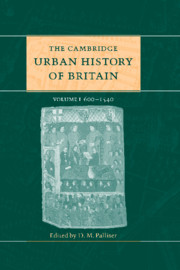Book contents
- Frontmatter
- Part I Introductory
- Part II The early middle ages 600–1300
- 3 General survey 600–1300
- 4 Power and authority 600–1300
- 5 Society and population 600–1300
- 6 The economy of British towns 600–1300
- 7 Churches, education and literacy in towns 600–1300
- 8 The topography of towns 600–1300
- 9 London from the post-Roman period to 1300
- 10 The large towns 600–1300
- 11 Small towns 600–1270
- Part III The later middle ages 1300–1540
- Part IV Regional surveys
- Part V Conclusion
- Appendix: Ranking lists of English medieval towns
- Select bibliography
- Index
- References
5 - Society and population 600–1300
from Part II - The early middle ages 600–1300
Published online by Cambridge University Press: 28 March 2008
- Frontmatter
- Part I Introductory
- Part II The early middle ages 600–1300
- 3 General survey 600–1300
- 4 Power and authority 600–1300
- 5 Society and population 600–1300
- 6 The economy of British towns 600–1300
- 7 Churches, education and literacy in towns 600–1300
- 8 The topography of towns 600–1300
- 9 London from the post-Roman period to 1300
- 10 The large towns 600–1300
- 11 Small towns 600–1270
- Part III The later middle ages 1300–1540
- Part IV Regional surveys
- Part V Conclusion
- Appendix: Ranking lists of English medieval towns
- Select bibliography
- Index
- References
Summary
proto-urban populations
In the early middle ages only a few rudimentary urban societies were to be found in Britain. Bede could describe eighth-century London as a market well frequented by its many visitors arriving by land and by sea – the reference is presumably to Lundenwic, to the west of the Roman city – and it is also known that there were extensive trading settlements or wics at other sites. By 800 Hamwic, Southampton's predecessor which was perhaps half the size of contemporary London, had streets laid out in a regular grid over a considerable area of some 100 acres (40 ha); it was fairly densely settled by a population living by trade and commodity manufacturing that could have been reckoned in thousands. Whether this was a settled community of permanent residents capable of evolving a distinct social structure, however, remains uncertain, and the casual manner in which the dead were disposed of may point to a society in which many inhabitants were transients and social bonds remained undeveloped. Other proto-urban centres existed in places with a range of central-place functions. Many of the former civitas capitals and coloniae of the Roman period became the setting for major public buildings such as royal palaces or important early churches, and in some cases an appreciable population composed of thegns, priests and their many retainers and servants would have gathered. Although at this distance impossible to measure, such city populations presumably totalled some hundreds of individuals; at a small number of central places the resident population could have considerably exceeded that size.
- Type
- Chapter
- Information
- The Cambridge Urban History of Britain , pp. 79 - 104Publisher: Cambridge University PressPrint publication year: 2000
References
- 7
- Cited by



